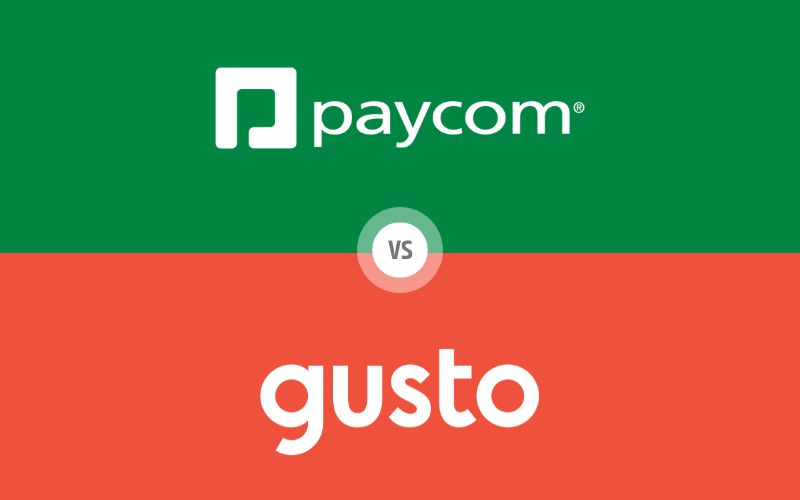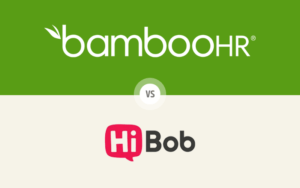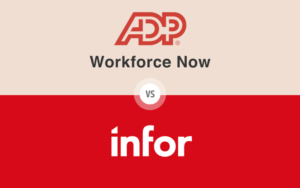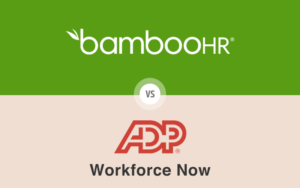When comparing Paycom vs Gusto, two of the leading Human Capital Management (HCM) platforms, businesses are often faced with the challenge of selecting the right solution for their unique HR needs. Whether you’re managing payroll, tracking employee attendance, or ensuring compliance, the choice between Paycom and Gusto can significantly impact your organization’s efficiency and growth. In this blog post, we’ll provide a detailed comparison of Paycom and Gusto across key areas to help you make an informed decision that aligns with your business objectives.
Table of Contents
User Interface and User Experience
When evaluating the user interface (UI) and user experience (UX) of Paycom vs Gusto, it’s essential to understand how each platform caters to its users through design, functionality, and overall ease of use. Both Paycom and Gusto aim to streamline HR tasks with their unique interfaces, but their approaches offer distinct experiences suited for different organizational needs.

Paycom User Interface and User Experience
Paycom presents a comprehensive and feature-rich interface designed to handle complex HR operations, making it particularly suitable for larger organizations. The platform’s dashboard centralizes a wide range of functions, which can be highly efficient for users familiar with such systems, though it might require a learning curve for those new to extensive HR tools.
Key Features of Paycom UI/UX:
- Comprehensive Dashboard: Paycom offers a centralized dashboard that provides access to various HR functions, making it ideal for detailed and multi-functional HR management.
- Customization: The platform allows significant customization, enabling users to tailor the interface to fit their specific workflows and organizational needs. For example, users can create custom reports, set up role-based access controls, and configure automated workflows to match their unique processes.
- Learning Curve: Due to its robust features, new users may find the interface requires some time to master, especially if they are not accustomed to handling complex HR systems.
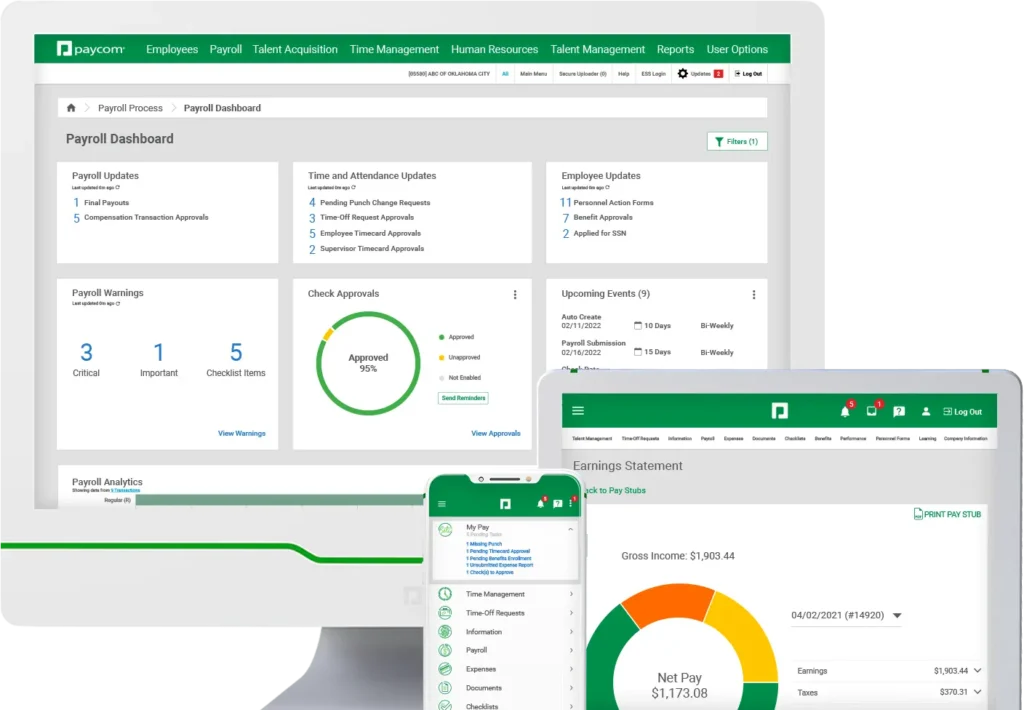
Despite its powerful capabilities, the complexity of Paycom’s interface might be challenging for users who prefer a more straightforward, intuitive system. This is particularly relevant for smaller organizations or those without extensive IT resources.
Gusto User Interface and User Experience
Gusto focuses on providing an intuitive and user-friendly interface that simplifies HR processes. The design is clean and accessible, making it an attractive option for small to medium-sized businesses that value ease of use. However, it’s worth noting that Gusto has been expanding its services to cater to larger businesses as well, through its Gusto Next initiative.
Key Features of Gusto UI/UX:
- Intuitive Design: Gusto’s interface is designed to be easy to navigate, with a logical layout that minimizes the learning curve and helps users quickly find the tools they need.
- Ease of Use: The simplicity of Gusto’s design ensures that even users with minimal HR experience can manage payroll, benefits, and other tasks effectively.
- Mobile Capabilities: Gusto offers strong mobile support, allowing users to manage HR functions on the go, which is particularly beneficial for busy business owners and managers.
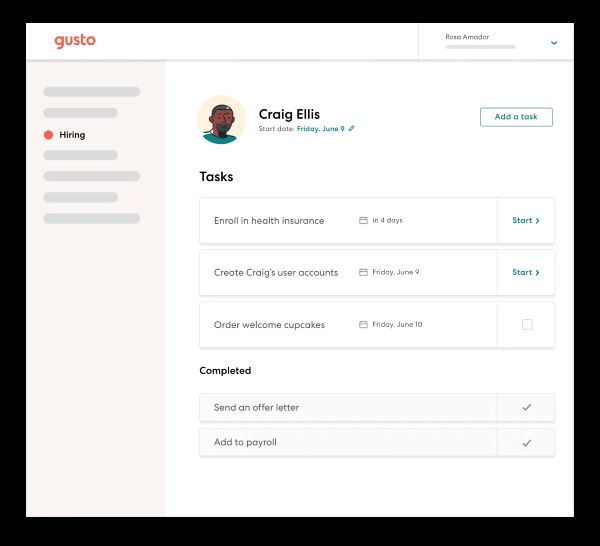
Gusto’s approach to UI and UX is particularly beneficial for organizations where quick adoption and straightforward processes are prioritized. However, the simplicity might limit customization for those needing more advanced features.
Comparison and Conclusion
Choosing between Paycom vs Gusto for user interface and user experience requires a deep understanding of your organization’s needs, resources, and priorities.
Paycom excels in providing a highly customizable and feature-rich interface, making it an excellent choice for large organizations with complex HR operations. The platform’s extensive customization options allow HR teams to tailor the system to their unique workflows, significantly enhancing productivity and user engagement. However, this depth of functionality comes with a steeper learning curve, which can be a hurdle for smaller organizations or those without dedicated IT support.
Gusto offers a more streamlined and user-friendly interface, ideal for organizations that prioritize ease of use and efficiency. The intuitive design reduces the learning curve, allowing users to quickly adapt to the system and perform tasks with minimal clicks. This makes Gusto particularly appealing for small to medium-sized businesses that need a straightforward, efficient HR solution. With their recent expansion efforts, Gusto is also becoming a viable option for larger businesses seeking a user-friendly system with growing capabilities.
In summary:
- Paycom is suited for large enterprises needing detailed control and customization. Its powerful capabilities and extensive features support multifaceted HR tasks but may require more significant training and adaptation efforts.
- Gusto is ideal for organizations seeking a straightforward, efficient, and user-friendly system. Its clean design and logical layout make it accessible and quick to learn, fostering high user engagement.
It’s worth noting that user reviews on third-party sites generally reflect these characteristics. Paycom users often praise its comprehensive features and customization options, while Gusto receives high marks for its ease of use and intuitive design.
Ultimately, the choice between Paycom vs Gusto depends on your organizational scale, the complexity of your HR needs, and your preference for customization versus ease of use. By carefully evaluating these factors, you can select the platform that will best support your HR strategy, enhance productivity, and meet your specific requirements. This decision will significantly impact how effectively your HR team operates and how well the system is adopted across your organization, driving overall business success.
Core HR Functions
Core HR functions are the backbone of any Human Capital Management (HCM) system, encompassing essential tasks such as employee data management, benefits administration, and compliance tracking. When comparing Paycom vs Gusto, it’s crucial to understand how each platform handles these core HR functions to determine which is the best fit for your organization.

Paycom Core HR Functions
Paycom offers a comprehensive suite of core HR functions designed to cater to the needs of larger organizations with complex HR requirements. The platform emphasizes automation and integration, ensuring that all HR processes are streamlined and easily managed from a central location.
Key Features of Paycom Core HR Functions:
- Employee Self-Service: Paycom empowers employees to manage their own HR-related tasks, such as updating personal information, viewing pay stubs, and managing benefits, reducing the administrative burden on HR teams.
- Benefits Administration: The platform offers robust tools for managing employee benefits, including automated enrollment, tracking, and reporting, which ensures accuracy and compliance.
- Payroll Integration: Paycom integrates payroll with core HR functions seamlessly, ensuring that all employee data is accurately reflected in payroll processes, thereby reducing errors and improving efficiency.
- Compliance Management: Paycom provides tools to help organizations stay compliant with various labor laws and regulations, including automated alerts and reporting features.
- Single-Database Architecture: Paycom’s unique single-database system ensures data consistency across all HR functions, minimizing errors and improving overall efficiency.
- Mobile Capabilities: The Paycom mobile app allows employees and managers to access HR functions on-the-go, enhancing flexibility and user engagement.

Paycom’s core HR functions are tailored for organizations that require a powerful and integrated system capable of handling complex HR tasks. The platform’s emphasis on automation and integration helps large companies manage their HR needs efficiently.
Gusto Core HR Functions
Gusto focuses on providing a user-friendly experience for small to medium-sized businesses, offering core HR functions that are easy to use and accessible. Gusto’s approach simplifies HR processes, making it an attractive option for businesses that may not have dedicated HR staff. Recently, Gusto has been expanding its services to cater to larger businesses as well.
Key Features of Gusto Core HR Functions:
- Employee Self-Service: Gusto’s intuitive interface allows employees to easily manage their own HR tasks, including benefits enrollment and time-off requests, which helps reduce the workload on HR administrators.
- Benefits Administration: Gusto simplifies benefits management with a user-friendly interface that guides both employees and administrators through the enrollment and management processes.
- Integrated Payroll: Like Paycom, Gusto integrates payroll with its core HR functions, ensuring that employee data is consistently updated across the platform, reducing the likelihood of errors.
- Compliance Support: Gusto offers tools to help businesses stay compliant with labor laws, including automated tax filing and state-specific compliance tracking, making it easier for organizations to navigate regulatory requirements.
- Mobile Access: Gusto provides a mobile-friendly interface, allowing users to access core HR functions from their smartphones or tablets.
- Scalable Solutions: With the introduction of Gusto Next, the platform is expanding its capabilities to serve larger businesses, offering more advanced features while maintaining its user-friendly approach.
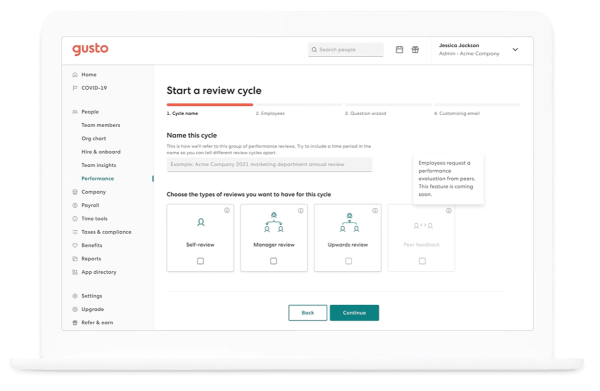
Gusto’s core HR functions are designed with simplicity in mind, making them ideal for smaller businesses that need a straightforward, efficient HR system without the complexities often required by larger enterprises.
Comparison and Conclusion
When comparing Paycom vs Gusto for core HR functions, the choice largely depends on the size and complexity of your organization’s HR needs.
Paycom offers a comprehensive and integrated suite of HR functions, making it well-suited for large organizations with complex HR requirements. Its emphasis on automation, integration, and compliance ensures that all HR tasks are managed efficiently from a centralized platform, reducing the potential for errors and improving overall HR operations.
Gusto, on the other hand, provides a more streamlined and user-friendly approach to core HR functions, making it an excellent choice for small to medium-sized businesses. Gusto’s simplicity and ease of use make it accessible to companies that may not have dedicated HR professionals, while still offering essential HR tools like benefits administration and compliance support.
In summary:
- Paycom is ideal for large enterprises that need a robust, integrated HR system capable of handling complex tasks across various HR functions. Its comprehensive features, single-database architecture, and automation capabilities make it a powerful tool for managing large-scale HR operations.
- Gusto is better suited for small to medium-sized businesses looking for an easy-to-use HR platform that simplifies core HR tasks. Its intuitive design, straightforward features, and state-specific compliance support make it accessible to businesses with limited HR resources. However, with its recent expansions, Gusto is also becoming a viable option for larger businesses seeking a user-friendly system with growing capabilities.
It’s worth noting that user reviews on third-party sites like TrustRadius generally reflect these characteristics. Paycom users often praise its comprehensive features and data integration, while Gusto receives high marks for its ease of use and customer support.
Ultimately, the decision between Paycom vs Gusto for core HR functions should be based on your organization’s size, HR complexity, and need for automation versus simplicity. By carefully assessing these factors, you can select the platform that will best support your HR strategy and operational efficiency, ensuring your organization’s HR processes run smoothly and effectively.
Payroll Management
Payroll management is a critical function within any Human Capital Management (HCM) system, ensuring employees are paid accurately and on time. When comparing Paycom vs Gusto, it’s important to understand how each platform handles payroll processing, compliance, and overall user experience to determine which is the best fit for your organization.

Paycom Payroll Management
Paycom is renowned for its robust payroll management capabilities, particularly suited for larger organizations with complex payroll needs. The platform is designed to handle intricate payroll processes with a focus on automation and integration, ensuring accuracy and compliance.
Key Features of Paycom Payroll Management:
- Automated Payroll Processing: Paycom automates the entire payroll process, from data entry to final payment, reducing the risk of errors and ensuring that employees are paid accurately and on time.
- Tax Management: Paycom includes comprehensive tax management tools that automatically calculate and file payroll taxes, ensuring compliance with federal, state, and local regulations.
- Real-Time Data Updates: Paycom integrates payroll with other HR functions, allowing real-time updates to employee data, which ensures that payroll calculations are always based on the most current information.
- Employee Self-Service: Employees can view their pay stubs, update tax information, and manage direct deposit options through Paycom’s self-service portal, reducing the administrative burden on HR teams.
- Single-Application Architecture: Paycom’s unique single-application system ensures data consistency across all payroll and HR functions, minimizing errors and improving overall efficiency.
- Mobile Access: The Paycom mobile app allows employees and managers to access payroll information and functions on-the-go, enhancing flexibility and user engagement.

Paycom’s payroll management system is designed to meet the needs of large enterprises that require detailed control over payroll processes, offering advanced features that ensure compliance and efficiency.
Gusto Payroll Management
Gusto is known for its user-friendly payroll management system, which is particularly well-suited for small to medium-sized businesses. Gusto simplifies payroll processing, making it easy for businesses to manage payroll with minimal effort and technical expertise. Recently, Gusto has been expanding its services to cater to larger businesses as well.
Key Features of Gusto Payroll Management:
- Simple Payroll Processing: Gusto offers a straightforward payroll processing system that guides users through each step, from entering hours to finalizing payments, making it easy for non-experts to manage payroll effectively.
- Automated Tax Filing: Gusto automatically calculates, files, and pays federal, state, and local payroll taxes, helping businesses stay compliant without the need for manual intervention.
- Direct Deposit and Payment Options: Gusto supports direct deposit and offers flexible payment options, allowing businesses to pay employees according to their preferred schedule.
- Employee Self-Service: Gusto’s self-service portal allows employees to access their pay stubs, manage their tax information, and update direct deposit details, which helps streamline payroll-related tasks.
- State-Specific Compliance: Gusto provides state-specific compliance support and automatic new hire reporting, which is particularly valuable for businesses operating in multiple states.
- Mobile-Friendly Interface: Gusto offers a mobile-friendly interface, allowing users to access payroll functions from their smartphones or tablets.
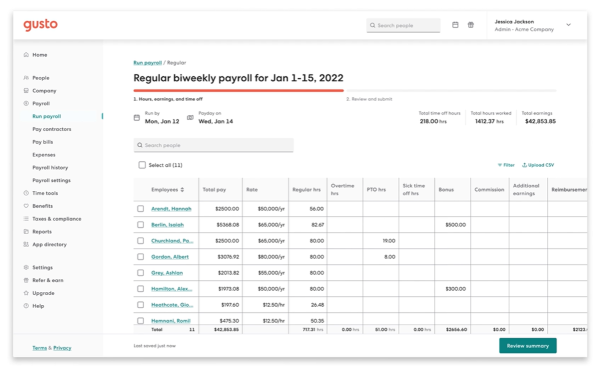
Gusto’s payroll management features are designed to simplify the payroll process, making it an ideal choice for small to medium-sized businesses that need an easy-to-use system with built-in compliance and automation.
Comparison and Conclusion
When comparing Paycom vs Gusto for payroll management, the choice depends on the size and complexity of your organization’s payroll needs.
Paycom offers a powerful and comprehensive payroll management system designed for large enterprises with complex payroll requirements. Its automation, real-time data updates, and advanced tax management tools ensure accuracy, compliance, and efficiency, making it an excellent choice for organizations with intricate payroll structures.
Gusto provides a more straightforward payroll management solution that is perfect for small to medium-sized businesses. Its simplicity, automated tax filing, and user-friendly interface make payroll processing easy and efficient, even for those with limited payroll experience. With its recent expansions, Gusto is also becoming a viable option for larger businesses seeking a user-friendly system with growing capabilities.
In summary:
- Paycom is ideal for large organizations that need a robust payroll management system capable of handling complex payroll processes and ensuring compliance across multiple jurisdictions. Its comprehensive features and single-application architecture make it a powerful tool for managing payroll at scale.
- Gusto is better suited for small to medium-sized businesses looking for a simple, easy-to-use payroll solution. Its focus on automation, user-friendliness, and state-specific compliance support makes it accessible to businesses with limited payroll resources, ensuring employees are paid accurately and on time.
It’s worth noting that user reviews on third-party sites like TrustRadius generally reflect these characteristics. Paycom users often praise its comprehensive features and data integration, while Gusto receives high marks for its ease of use and customer support.
Ultimately, the decision between Paycom vs Gusto for payroll management should be based on the complexity of your payroll needs, the size of your organization, and your preference for advanced features versus simplicity. By carefully evaluating these factors, you can select the platform that will best support your payroll processing requirements, ensuring smooth and accurate payroll management for your business.
Time and Attendance Tracking
Time and attendance tracking is essential for ensuring accurate payroll, monitoring employee productivity, and maintaining compliance with labor laws. When comparing Paycom vs Gusto, it’s important to evaluate how each platform handles time and attendance management to determine which one best suits your organization’s needs.

Paycom Time and Attendance Tracking
Paycom offers a comprehensive time and attendance tracking system that is well-suited for larger organizations with complex scheduling and time-tracking needs. The platform integrates time and attendance data directly with payroll and other HR functions, ensuring seamless operations and accurate record-keeping.
Key Features of Paycom Time and Attendance Tracking:
- Automated Time Tracking: Paycom automates the process of tracking employee hours, including clock-ins, clock-outs, breaks, and overtime, which reduces the potential for errors and ensures that all time worked is accurately recorded.
- Customizable Scheduling: Paycom provides advanced scheduling tools that allow managers to create and manage complex work schedules, including shift planning and overtime management, tailored to the specific needs of the organization.
- Real-Time Data Integration: Time and attendance data is integrated in real-time with payroll, ensuring that employees are paid accurately for the hours they work, with all data reflected instantly across the platform.
- Compliance Management: Paycom helps organizations stay compliant with labor laws by automating overtime calculations and ensuring that all tracked time adheres to legal requirements.
- Advanced Security Features: Paycom offers geofencing and facial recognition capabilities for enhanced security and accuracy in time tracking, particularly useful for organizations with multiple locations or remote workers.
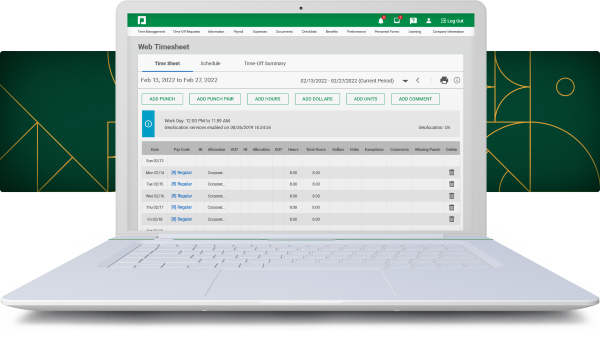
Paycom’s time and attendance tracking system is designed to handle the demands of large, complex organizations, offering detailed control and real-time data integration that ensures accuracy and compliance.
Gusto Time and Attendance Tracking
Gusto provides a simpler, more streamlined approach to time and attendance tracking, making it an attractive option for small to medium-sized businesses. Gusto’s focus on ease of use ensures that even businesses without dedicated HR staff can effectively manage employee time and attendance.
Key Features of Gusto Time and Attendance Tracking:
- Easy Clock-In/Clock-Out: Gusto offers a straightforward time-tracking system that allows employees to easily clock in and out through the platform, simplifying the process of tracking work hours.
- Basic Scheduling Tools: Gusto provides essential scheduling tools that help managers set and manage employee work schedules, making it easy to track who is working and when.
- Integration with Payroll: Time and attendance data is automatically integrated with Gusto’s payroll system, ensuring that all recorded hours are accurately reflected in employee pay, reducing the risk of errors.
- Compliance Support: Gusto helps small businesses stay compliant with labor laws by automating overtime calculations and offering basic tools to ensure that time-tracking practices meet legal standards.
- Mobile Time Tracking: Gusto allows employees to clock in/out via computer or mobile devices, offering flexibility for businesses with remote or on-the-go workers.
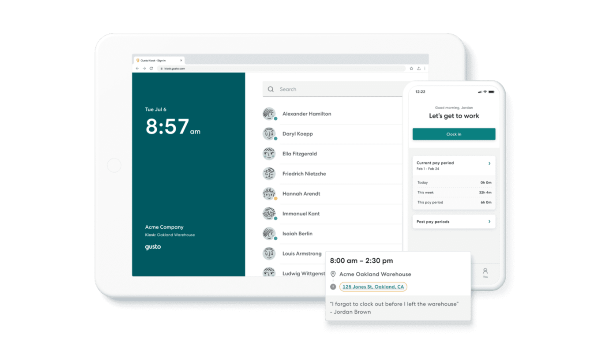
It’s important to note that Gusto’s time tracking features are not available in all of their plans, so potential users should check which plan includes the features they need.
Comparison and Conclusion
When comparing Paycom vs Gusto for time and attendance tracking, the choice depends on the complexity of your organization’s scheduling needs and the scale of your operations.
Paycom offers a robust and highly integrated time and attendance tracking system, ideal for large organizations with complex scheduling requirements. Its automated tracking, real-time data integration, and advanced security features ensure that all time worked is accurately recorded and reflected in payroll, making it a powerful tool for managing large workforces.
Gusto provides a simpler, more accessible time and attendance tracking solution that is perfect for small to medium-sized businesses. Its user-friendly design, basic scheduling tools, and seamless integration with payroll make it easy to manage employee hours without the need for extensive training or HR resources.
In summary:
- Paycom is ideal for large organizations that require a comprehensive, integrated time and attendance tracking system capable of handling complex schedules and ensuring compliance with labor laws. Its advanced features, including geofencing and facial recognition, make it a powerful tool for managing time-tracking at scale.
- Gusto is better suited for small to medium-sized businesses looking for a straightforward, easy-to-use time and attendance tracking solution. Its focus on simplicity, mobile accessibility, and integration with payroll ensures accurate time management without added complexity.
User reviews on third-party sites like TrustRadius generally reflect these characteristics. Paycom users often praise its comprehensive features and data integration, while Gusto receives high marks for its ease of use and user-friendly interface.
Ultimately, the decision between Paycom vs Gusto for time and attendance tracking should be based on your organization’s size, the complexity of your scheduling needs, and your preference for advanced features versus simplicity. By carefully evaluating these factors, you can select the platform that will best support your time-tracking requirements, ensuring accurate and efficient management of employee hours.
Benefits Administration
Benefits administration is a crucial aspect of Human Capital Management (HCM), directly impacting employee satisfaction and retention. When comparing Paycom vs Gusto, it’s important to understand how each platform handles benefits administration to determine which solution best meets your organization’s needs.

Paycom Benefits Administration
Paycom offers a comprehensive and customizable benefits administration system designed to support organizations with complex benefits needs. The platform integrates benefits management with other HR functions, ensuring seamless operations and efficient management.
Key Features of Paycom Benefits Administration:
- Comprehensive Benefits Management: Paycom allows for the management of a wide range of benefits, including health, dental, vision, retirement plans, and more, making it suitable for organizations with diverse employee needs.
- Automated Enrollment: The platform automates the benefits enrollment process, guiding employees through selecting and managing their benefits with minimal HR intervention, which reduces administrative workload.
- Employee Self-Service: Paycom’s self-service portal enables employees to manage their own benefits, including enrolling in plans, making changes, and viewing benefits information, providing them with greater control and reducing the need for HR involvement.
- Compliance Management: Paycom helps organizations stay compliant with various regulations related to benefits administration, including ACA reporting and other legal requirements, ensuring that benefits are managed according to the law.
- Benefits Carrier Connections: Paycom offers direct connections with benefits carriers, streamlining the process of managing and updating employee benefits information.
- COBRA Administration: Paycom provides tools for managing COBRA (Consolidated Omnibus Budget Reconciliation Act) benefits, helping organizations comply with this complex area of benefits administration.

Paycom’s benefits administration system is tailored for larger organizations that require detailed control and customization of their benefits offerings, providing a robust solution that integrates seamlessly with other HR processes.
Gusto Benefits Administration
Gusto focuses on simplicity and ease of use in benefits administration, making it an excellent choice for small to medium-sized businesses. Gusto’s platform is designed to be user-friendly, ensuring that benefits management is straightforward for both employees and administrators.
Key Features of Gusto Benefits Administration:
- Simple Benefits Management: Gusto provides an easy-to-use platform for managing benefits such as health insurance, retirement plans, and other employee perks, making it accessible for businesses without dedicated HR resources.
- Automated Enrollment and Management: Gusto automates many aspects of benefits administration, including open enrollment, eligibility tracking, and employee notifications, reducing the administrative burden on HR staff.
- Employee Self-Service: Gusto’s intuitive self-service portal allows employees to enroll in benefits, view their coverage, and make changes as needed, empowering them to manage their own benefits with ease.
- Compliance Support: Gusto helps small businesses stay compliant with benefits-related regulations by providing tools for ACA reporting and other compliance requirements, ensuring that all benefits administration practices meet legal standards.
- Health Insurance Options: In some plans, Gusto offers health insurance at no additional cost to the employer, making it an attractive option for small businesses looking to provide comprehensive benefits.
- Health Reimbursement Arrangements: Gusto provides options for setting up health reimbursement arrangements (HRAs), offering flexibility in how businesses can support employee health care costs.
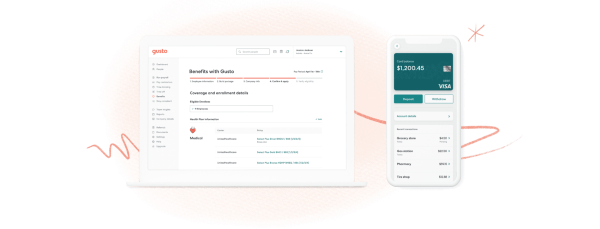
It’s important to note that Gusto’s benefits administration features may vary depending on the plan selected, so potential users should carefully review the options available in each plan.
Comparison and Conclusion
When comparing Paycom vs Gusto for benefits administration, the choice depends on the size and complexity of your organization’s benefits needs.
Paycom offers a comprehensive and customizable benefits administration system, ideal for large organizations with diverse and complex benefits requirements. Its integrated approach, automated enrollment, and compliance management tools ensure that benefits are managed efficiently and in line with legal requirements, making it a powerful tool for managing benefits at scale.
Gusto, on the other hand, provides a simpler, more straightforward benefits administration system that is perfect for small to medium-sized businesses. Its focus on ease of use, automated management, and employee self-service makes it accessible to businesses without extensive HR resources, ensuring that benefits administration is handled smoothly and efficiently.
In summary:
- Paycom is ideal for large organizations that need a robust, integrated benefits administration system capable of handling complex benefits offerings and ensuring compliance. Its comprehensive features, including carrier connections and COBRA administration, make it a strong choice for managing benefits at scale.
- Gusto is better suited for small to medium-sized businesses looking for a user-friendly benefits administration solution. Its simplicity, automation features, and unique offerings like built-in health insurance options make it easy to manage employee benefits without the need for extensive HR involvement.
User reviews on third-party sites generally reflect these characteristics. Paycom users often praise its comprehensive features and customization options, while Gusto receives high marks for its ease of use and straightforward approach to benefits administration.
Ultimately, the decision between Paycom vs Gusto for benefits administration should be based on your organization’s size, the complexity of your benefits offerings, and your preference for advanced features versus simplicity. By carefully evaluating these factors, you can select the platform that will best support your benefits administration needs, ensuring that your employees are well-supported and satisfied with their benefits options.
Performance Management
Performance management is a key function within Human Capital Management (HCM) systems, helping organizations align employee performance with business goals. When comparing Paycom vs Gusto, it’s important to assess how each platform supports performance management to determine which is the best fit for your organization.

Paycom Performance Management
Paycom offers a robust performance management system designed to meet the needs of larger organizations with complex performance evaluation processes. The platform focuses on providing comprehensive tools that help managers track, assess, and improve employee performance effectively.
Key Features of Paycom Performance Management:
- Goal Setting and Tracking: Paycom allows managers and employees to set, track, and align individual goals with organizational objectives, ensuring that everyone is working towards common business goals.
- Performance Reviews: The platform supports various types of performance reviews, including annual reviews, 360-degree feedback, and continuous performance evaluations, providing flexibility to meet different organizational needs.
- Continuous Feedback: Paycom encourages a culture of continuous improvement by enabling ongoing feedback between managers and employees, helping to address performance issues in real-time and keep employees engaged.
- Integration with Learning and Development: Paycom integrates performance management with learning and development tools, enabling organizations to identify skill gaps and provide targeted training to improve employee performance.
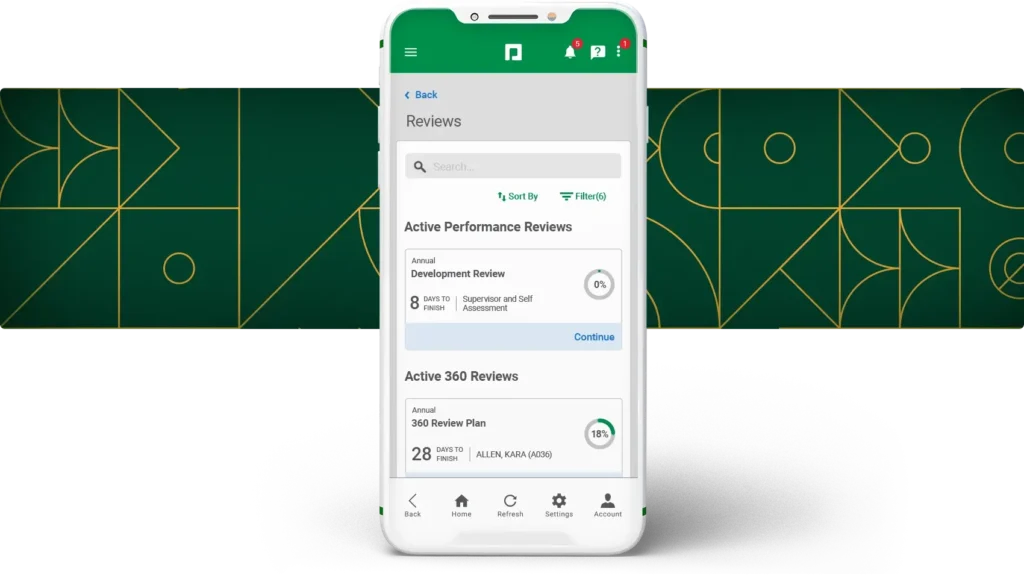
Paycom’s performance management system is tailored for organizations that require a comprehensive approach to managing and improving employee performance, offering advanced tools that ensure alignment with business goals and support continuous improvement.
Gusto Performance Management
Gusto primarily focuses on payroll and basic HR functions, with more limited offerings in performance management compared to dedicated performance management systems. Their platform is designed with simplicity in mind, catering primarily to small to medium-sized businesses.
Key Features of Gusto Performance Management:
- Basic Goal Tracking: Gusto offers some basic features for tracking employee goals, though these are not as comprehensive as those found in dedicated performance management systems.
- Simple Feedback Tools: Gusto provides basic tools for giving and receiving feedback, which can help facilitate communication between managers and employees.
- User-Friendly Interface: Gusto’s intuitive design makes it easy for managers and employees to navigate the available performance management features, reducing the learning curve for small businesses.
- Integration with Core HR Functions: While limited in scope, Gusto’s performance management features integrate well with its core payroll and HR functions, providing a unified experience for small businesses.
It’s important to note that Gusto’s performance management features are relatively new and may not be available in all plans. They are designed to be accessible and easy to use, making them suitable for small businesses that need basic performance management functionality alongside core HR and payroll services.
Comparison and Conclusion
When comparing Paycom vs Gusto for performance management, the choice depends on the size of your organization and the complexity of your performance management needs.
Paycom offers a comprehensive and integrated performance management system, ideal for large organizations that require detailed tracking, goal alignment, and continuous feedback. Its advanced features support a culture of continuous improvement and ensure that employee performance is aligned with business objectives, making it a powerful tool for managing performance at scale.
Gusto, while primarily known for its payroll and basic HR functions, offers some simple performance management tools that can be sufficient for small businesses with basic needs. Its straightforward design and integration with core HR functions make it accessible for businesses that may not have dedicated HR professionals.
In summary:
- Paycom is ideal for large organizations that need a robust performance management system capable of handling complex evaluation processes and aligning employee performance with business goals. Its comprehensive tools make it a strong choice for managing performance at scale.
- Gusto is better suited for small businesses looking for basic performance management functionality integrated with their payroll and HR system. While its performance management features are limited, they can be sufficient for businesses with simple needs and limited HR resources.
User reviews on platforms like G2 and Capterra generally reflect these characteristics. Paycom users often praise its comprehensive performance management features, while Gusto receives high marks for its user-friendly interface and integration of basic HR functions.
Ultimately, the decision between Paycom vs Gusto for performance management should be based on your organization’s size, the complexity of your performance evaluation processes, and your overall HR management needs. If you require advanced performance management tools, Paycom is likely the better choice. However, if you’re a small business primarily looking for payroll and basic HR functionality with some simple performance management features, Gusto could be a suitable option.
Talent Management and Recruiting
Talent management and recruiting are crucial aspects of Human Capital Management (HCM) systems, helping organizations attract, develop, and retain top talent. When comparing Paycom vs Gusto, it’s important to evaluate how each platform supports talent management and recruiting to determine which is the best fit for your organization.

Paycom Talent Management and Recruiting
Paycom offers a comprehensive talent management and recruiting system that is designed to meet the needs of larger organizations. The platform provides advanced tools for managing the entire employee lifecycle, from recruiting and onboarding to development and retention.
Key Features of Paycom Talent Management and Recruiting:
- Applicant Tracking System (ATS): Paycom’s robust ATS streamlines the recruiting process, enabling organizations to manage job postings, track applications, and communicate with candidates efficiently.
- Onboarding: Paycom simplifies the onboarding process with automated workflows that ensure new hires are integrated smoothly into the organization, reducing administrative burden and improving the employee experience.
- Employee Development: Paycom offers tools for managing employee development, including performance evaluations, goal setting, and training, helping to align individual growth with organizational goals.
- Succession Planning: The platform supports succession planning by identifying high-potential employees and preparing them for leadership roles, ensuring long-term organizational stability.

Paycom’s talent management and recruiting system is tailored for large organizations that require a comprehensive approach to managing talent, offering advanced features that support recruiting, development, and retention efforts across the entire employee lifecycle.
Gusto Talent Management and Recruiting
Gusto primarily focuses on payroll and basic HR functions, with more limited offerings in talent management and recruiting compared to dedicated systems like Paycom. Their platform is designed with simplicity in mind, catering primarily to small to medium-sized businesses.
Key Features of Gusto Talent Management and Recruiting:
- Basic Hiring Tools: Gusto offers simple tools for hiring, such as offer letter templates and basic candidate management, but these are not as comprehensive as a full-fledged ATS.
- Onboarding Assistance: Gusto provides basic onboarding features, including digital document signing and automated tax form collection, to help streamline the new hire process.
- Simple Employee Management: While not extensive, Gusto offers basic employee management tools that can help with tracking employee information and performance.
- User-Friendly Interface: Gusto’s intuitive design makes it easy for managers to navigate the available hiring and employee management features, reducing the learning curve for small businesses.
It’s important to note that Gusto’s talent management and recruiting features are relatively basic compared to dedicated systems like Paycom. They are designed to be accessible and easy to use, making them suitable for small businesses that need fundamental hiring and employee management functionality alongside core payroll services.
Comparison and Conclusion
When comparing Paycom vs Gusto for talent management and recruiting, the choice depends on the size of your organization and the complexity of your talent management needs.
Paycom offers a comprehensive and integrated talent management and recruiting system, ideal for large organizations that require advanced tools for managing the entire employee lifecycle. Its robust ATS, onboarding, and development features ensure that organizations can attract, develop, and retain top talent effectively.
Gusto, while primarily known for its payroll and basic HR functions, offers some simple hiring and employee management tools that can be sufficient for small businesses with basic needs. Its straightforward design and integration with core HR functions make it accessible for businesses that may not have dedicated HR professionals.
In summary:
- Paycom is ideal for large organizations that need a robust talent management and recruiting system capable of handling complex hiring, development, and succession planning processes. Its comprehensive tools make it a strong choice for managing talent at scale.
- Gusto is better suited for small businesses looking for basic hiring and employee management functionality integrated with their payroll and HR system. While its features in this area are limited, they can be sufficient for businesses with simple needs and limited HR resources.
User reviews on platforms like G2 and Capterra generally reflect these characteristics. Paycom users often praise its comprehensive talent management features, while Gusto receives high marks for its user-friendly interface and integration of basic HR functions with payroll.
Ultimately, the decision between Paycom vs Gusto for talent management and recruiting should be based on your organization’s size, the complexity of your hiring and development processes, and your overall HR management needs. If you require advanced talent management tools, Paycom is likely the better choice. However, if you’re a small business primarily looking for payroll and basic HR functionality with some simple hiring features, Gusto could be a suitable option.
Learning and Development
Learning and development are critical components of an effective Human Capital Management (HCM) system, helping organizations enhance employee skills, foster growth, and align workforce capabilities with business goals. When comparing Paycom vs Gusto, it’s essential to assess how each platform supports learning and development initiatives to determine which is the best fit for your organization.

Paycom Learning and Development
Paycom offers a comprehensive learning and development system designed to meet the needs of larger organizations that require robust tools for employee training and growth. The platform integrates learning management with other HR functions, ensuring a seamless experience from onboarding to ongoing development.
Key Features of Paycom Learning and Development:
- Learning Management System (LMS): Paycom’s LMS allows organizations to create, manage, and track employee training programs. The system supports a wide range of training formats, including online courses, webinars, and in-person training sessions.
- Onboarding Training: Paycom includes tools for developing and delivering onboarding programs that help new hires quickly acclimate to the company culture and processes, ensuring a smooth transition into the organization.
- Performance-Linked Development: Paycom integrates learning and development with performance management, enabling managers to assign training based on performance reviews, skills assessments, and identified gaps, ensuring targeted employee growth.
- Compliance Training: Paycom’s LMS includes features for managing mandatory compliance training, helping organizations stay compliant with industry regulations and legal requirements.
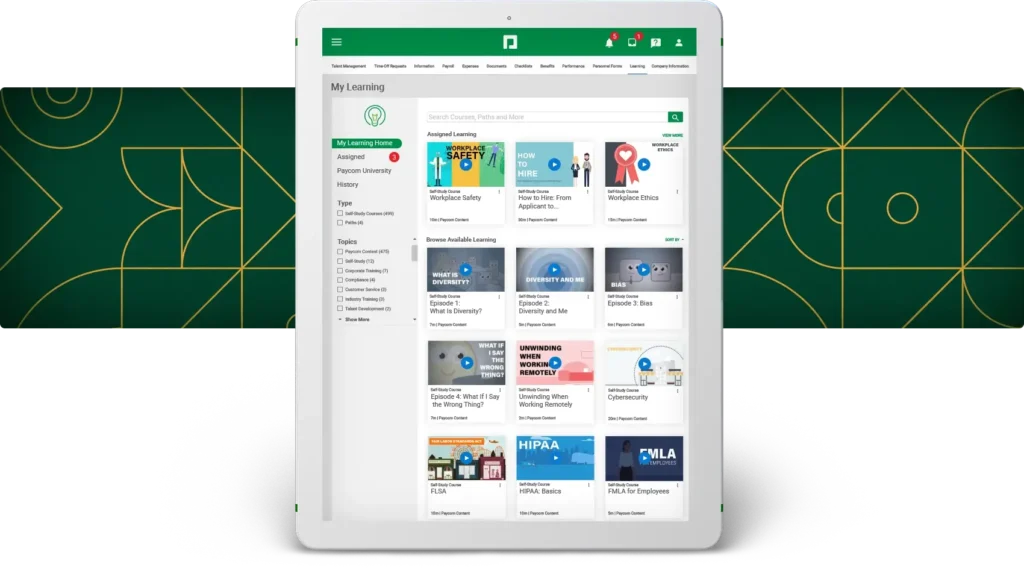
Paycom’s learning and development system is tailored for large organizations that require a comprehensive approach to employee training and development, offering advanced tools that support continuous learning and skill enhancement.
Gusto Learning and Development
Gusto primarily focuses on payroll and basic HR functions, with more limited offerings in learning and development compared to dedicated systems like Paycom. Their platform is designed with simplicity in mind, catering primarily to small to medium-sized businesses.
Key Features of Gusto Learning and Development:
- Basic Onboarding Tools: Gusto offers simple onboarding tools that help new hires get started with essential paperwork and company information.
- Limited Learning Resources: While Gusto provides some basic resources for employee development, it does not offer a comprehensive learning management system.
- Employee Self-Service: Gusto’s platform allows employees to access basic HR information and documents, but its learning-specific features are limited.
- Integration with HR Functions: Gusto integrates various HR functions, but its learning and development integration is not as comprehensive as more specialized platforms.
It’s important to note that Gusto’s learning and development features are relatively basic compared to dedicated systems like Paycom. They are designed to be accessible and easy to use, making them suitable for small businesses that need fundamental onboarding and basic employee development functionality alongside core payroll services.
Comparison and Conclusion
When comparing Paycom vs Gusto for learning and development, the choice depends on the size of your organization and the complexity of your training needs.
Paycom offers a robust and integrated learning and development system, ideal for large organizations that require comprehensive tools for managing employee training and growth. Its advanced LMS, performance-linked development, and compliance training features ensure that employees are continuously developing skills that align with business objectives.
Gusto, while primarily known for its payroll and basic HR functions, offers limited learning and development tools that can be sufficient for small businesses with basic needs. Its straightforward design and integration with core HR functions make it accessible for businesses that may not have dedicated HR professionals, but it may not meet the needs of organizations requiring extensive training programs.
In summary:
- Paycom is ideal for large organizations that need a comprehensive learning and development system capable of handling complex training programs and ensuring continuous employee growth. Its advanced features make it a strong choice for managing learning at scale.
- Gusto is better suited for small businesses looking for basic onboarding and employee management functionality integrated with their payroll and HR system. While its features in this area are limited, they can be sufficient for businesses with simple needs and limited HR resources.
User reviews on platforms like G2 and Capterra generally reflect these characteristics. Paycom users often praise its comprehensive learning and development features, while Gusto receives high marks for its user-friendly interface and integration of basic HR functions with payroll.
Ultimately, the decision between Paycom vs Gusto for learning and development should be based on your organization’s size, the complexity of your training needs, and your overall HR management requirements. If you require advanced learning and development tools, Paycom is likely the better choice. However, if you’re a small business primarily looking for payroll and basic HR functionality with some simple onboarding features, Gusto could be a suitable option.
Reporting and Analytics
Reporting and analytics are essential components of a Human Capital Management (HCM) system, providing organizations with the insights needed to make informed decisions about their workforce. When comparing Paycom vs Gusto, it’s important to assess how each platform handles reporting and analytics to determine which solution best meets your organization’s needs.

Paycom Reporting and Analytics
Paycom offers a powerful reporting and analytics system designed to meet the needs of larger organizations that require detailed, customizable reports and deep data insights. The platform integrates reporting across all HR functions, allowing organizations to analyze and track various metrics in real-time.
Key Features of Paycom Reporting and Analytics:
- Customizable Reports: Paycom allows users to create and customize reports tailored to specific business needs, providing flexibility in how data is presented and analyzed. This includes the ability to generate reports on payroll, employee performance, benefits, and more.
- Real-Time Analytics: Paycom’s system provides real-time data analytics, enabling organizations to monitor key metrics as they happen. This real-time capability ensures that decision-makers have the most up-to-date information at their fingertips.
- Integrated Data: Paycom integrates data from various HR functions into a single reporting platform, ensuring consistency and accuracy across all reports. This integration allows for comprehensive analysis that spans multiple areas of HR, such as payroll, time and attendance, and benefits.
- Advanced Visualization Tools: Paycom offers advanced visualization tools that help users interpret complex data through charts, graphs, and dashboards, making it easier to identify trends and make data-driven decisions.
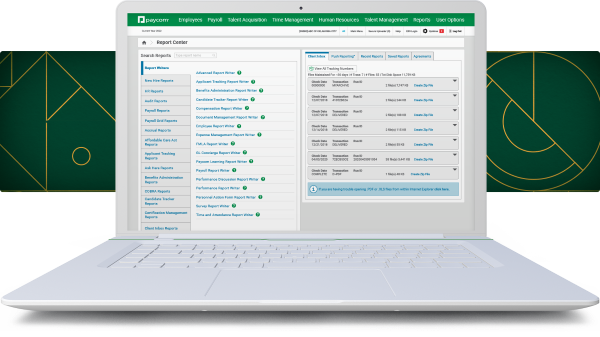
Paycom’s reporting and analytics system is tailored for organizations that need detailed, customizable reports and real-time insights, offering robust tools that support strategic decision-making.
Gusto Reporting and Analytics
Gusto provides a user-friendly approach to reporting and analytics, making it an excellent choice for small to medium-sized businesses. While designed for ease of use, Gusto offers more advanced reporting capabilities than might be expected for its target market.
Key Features of Gusto Reporting and Analytics:
- Pre-Built Reports: Gusto offers a range of pre-built reports covering essential HR metrics, such as payroll summaries, tax filings, and employee benefits. These reports provide quick access to commonly needed information.
- Custom Report Builder: Gusto includes a custom report builder that allows users to create and save tailored reports, offering more flexibility than basic pre-built options.
- Basic Analytics: Gusto provides analytics tools that help businesses track key HR metrics over time, allowing for trend analysis and informed decision-making.
- User-Friendly Interface: Gusto’s intuitive interface makes it easy for users to navigate and generate reports, designed to be accessible even for those without extensive data analysis experience.
- Integration with HR Functions: Gusto integrates reporting with its other HR functions, ensuring data consistency across the platform and providing a holistic view of HR operations.
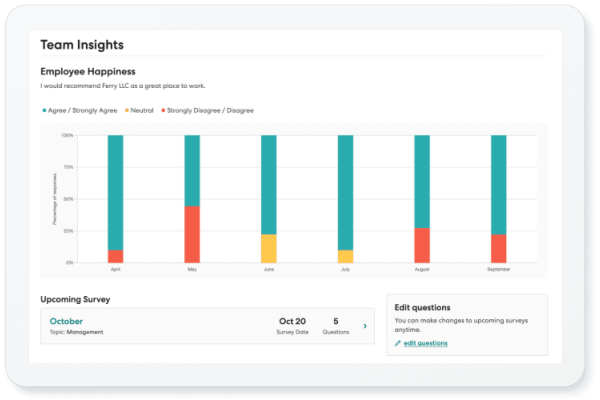
Gusto’s reporting and analytics features are designed to balance ease of use with customization options, making it a strong choice for small to medium-sized businesses that need both straightforward and somewhat advanced reporting capabilities.
Comparison and Conclusion
When comparing Paycom vs Gusto for reporting and analytics, the choice depends on the size and complexity of your organization’s data needs.
Paycom offers a comprehensive and highly customizable reporting and analytics system, ideal for large organizations that require detailed reports and real-time data insights. Its advanced features, such as extensive customization options, integrated data across all HR functions, and sophisticated visualization tools, make it a powerful solution for organizations with complex reporting needs.
Gusto provides a user-friendly reporting and analytics solution that offers more depth than might be expected for its target market of small to medium-sized businesses. While not as advanced as Paycom, Gusto’s combination of pre-built reports, custom report builder, and basic analytics tools provides a robust solution for smaller organizations.
In summary:
- Paycom is ideal for large organizations that need a robust reporting and analytics system capable of generating highly detailed, customizable reports and providing real-time data insights across all HR functions. Its comprehensive tools make it a strong choice for managing complex HR data at scale.
- Gusto is well-suited for small to medium-sized businesses looking for a user-friendly reporting and analytics solution with more advanced capabilities than typical small business platforms. Its balance of simplicity and customization options makes it an excellent choice for businesses that need flexible reporting without overwhelming complexity.
User reviews on platforms like G2 and Capterra generally reflect these characteristics. Paycom users often praise its comprehensive reporting capabilities and data integration, while Gusto receives high marks for its user-friendly interface and the balance between ease of use and reporting flexibility.
Ultimately, the decision between Paycom vs Gusto for reporting and analytics should be based on your organization’s size, the complexity of your data needs, and your preference for advanced features versus user-friendliness. By carefully evaluating these factors, you can select the platform that will best support your reporting and analytics requirements, ensuring that your organization has the insights needed to make informed decisions.
Compliance and Security
Compliance and security are critical components of any Human Capital Management (HCM) system, ensuring that sensitive employee data is protected and that business operations adhere to regulatory standards. When comparing Paycom vs Gusto, it’s important to understand how each platform addresses compliance and security to determine which solution best meets your organization’s needs.

Paycom Compliance and Security
Paycom offers a robust compliance and security framework designed to meet the needs of larger organizations with complex regulatory requirements. The platform provides a comprehensive set of tools that help businesses manage compliance and secure sensitive employee data effectively.
Key Features of Paycom Compliance and Security:
- Comprehensive Compliance Management: Paycom helps organizations stay compliant with various labor laws, tax regulations, and industry standards by automating compliance-related tasks, such as reporting, tax filing, and employee documentation.
- Advanced Data Security: Paycom employs state-of-the-art security measures, including 256-bit encryption, multi-factor authentication, and a 24/7 security command center to protect sensitive employee data from unauthorized access and breaches.
- Automated Reporting: The platform offers detailed reporting tools that help organizations generate necessary compliance documentation quickly and accurately.
- Role-Based Access Control: Paycom allows organizations to implement role-based access control with customized permissions and audit trails, ensuring that only authorized personnel have access to specific data and functions.
- Certifications: Paycom holds ISO 9001, ISO 22301, ISO 27001, and SOC 2 certifications, demonstrating its commitment to maintaining high standards of quality, business continuity, information security, and operational control.
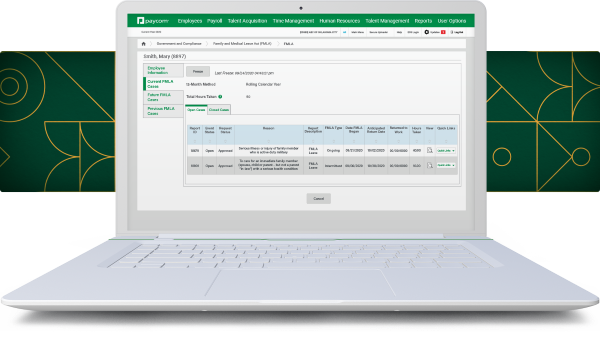
Paycom’s compliance and security features are tailored for large organizations that require a comprehensive approach to managing regulatory requirements and protecting sensitive data, offering advanced tools that ensure compliance and security at scale.
Gusto Compliance and Security
Gusto provides a streamlined approach to compliance and security, making it an excellent choice for small to medium-sized businesses. Gusto’s platform is designed to simplify compliance management while maintaining robust security measures to protect employee data.
Key Features of Gusto Compliance and Security:
- Automated Compliance Support: Gusto helps businesses stay compliant with labor laws, tax regulations, and other legal requirements by automating tasks such as payroll tax filing, benefits reporting, and new hire paperwork.
- Data Protection: Gusto employs industry-standard security measures, including 256-bit SSL encryption and secure servers, to protect employee information from unauthorized access and breaches.
- User Access Control: Gusto offers user permissions controls that allow businesses to manage who has access to specific data and functions within the platform, ensuring that only authorized personnel can view or edit sensitive information.
- Certifications: Gusto is SOC 1 and SOC 2 certified, demonstrating its commitment to maintaining high standards of operational control and data security.
Gusto’s compliance and security features are designed to be accessible and easy to manage, making it a strong choice for small to medium-sized businesses that need a straightforward solution for maintaining compliance and securing employee data.
Comparison and Conclusion
When comparing Paycom vs Gusto for compliance and security, the choice depends on the size and complexity of your organization’s needs in these areas.
Paycom offers a comprehensive and advanced compliance and security framework, ideal for large organizations that require detailed control over regulatory compliance and data protection. Its automated compliance management, advanced security measures, and multiple certifications make it a powerful tool for managing compliance and security at scale.
Gusto provides a simpler, more user-friendly compliance and security solution that is perfect for small to medium-sized businesses. Its automated compliance support, robust data protection, and essential certifications make it accessible for businesses without extensive IT or HR resources.
In summary:
- Paycom is ideal for large organizations that need a robust compliance and security system capable of handling complex regulatory requirements and protecting sensitive employee data. Its comprehensive tools and advanced certifications make it a strong choice for managing compliance and security at scale.
- Gusto is better suited for small to medium-sized businesses looking for a user-friendly compliance and security solution. Its simplicity and focus on ease of use, combined with strong security measures and relevant certifications, make it an excellent choice for businesses with limited resources.
User experiences reported on platforms like G2 and Capterra generally align with these characteristics, with Paycom users often praising its comprehensive compliance tools and Gusto users appreciating its user-friendly approach to security and compliance.
Ultimately, the decision between Paycom vs Gusto for compliance and security should be based on your organization’s size, the complexity of your regulatory requirements, and your preference for advanced features versus simplicity. By carefully evaluating these factors, you can select the platform that will best support your compliance and security needs, ensuring that it aligns with your organization’s goals while maintaining high standards of data protection and regulatory compliance.
Integration and Compatibility
Integration and compatibility are crucial considerations when selecting a Human Capital Management (HCM) system, as they determine how well the platform will work with other software and systems already in place. When comparing Paycom vs Gusto, it’s important to assess how each platform handles integration and compatibility to ensure seamless operations across your organization.

Paycom Integration and Compatibility
Paycom is designed with large organizations in mind, offering robust integration capabilities that allow it to connect with various third-party applications and internal systems. This flexibility ensures that Paycom can be incorporated into existing IT infrastructures with minimal disruption.
Key Features of Paycom Integration and Compatibility:
- Wide Range of Integrations: Paycom supports integration with a variety of third-party applications, including accounting software, time-tracking tools, and other HR-related systems.
- API Access: Paycom provides API access, enabling custom integrations with other software solutions. This is particularly useful for large organizations that have unique system requirements and need tailored integrations to meet their specific needs.
- Seamless Data Synchronization: Paycom’s single-database architecture ensures that data is consistently updated and synchronized across all integrated systems, reducing the risk of errors and ensuring that all departments have access to the most current information.
- HRIS Integration: Paycom can be integrated with other Human Resource Information Systems (HRIS), allowing for a comprehensive view of employee data across various functions, from payroll and benefits to time and attendance.
Paycom’s integration and compatibility features are designed to meet the needs of large organizations that require complex, customized integrations. Its robust capabilities ensure that Paycom can be seamlessly incorporated into existing IT environments, making it a powerful tool for organizations with diverse system requirements.
Gusto Integration and Compatibility
Gusto offers a more straightforward approach to integration and compatibility, making it an excellent choice for small to medium-sized businesses. Gusto’s platform is designed to be user-friendly, with easy-to-implement integrations that require minimal technical expertise.
Key Features of Gusto Integration and Compatibility:
- Essential Integrations: Gusto integrates with a range of popular business applications, including accounting software like QuickBooks and Xero, time-tracking tools, and point-of-sale systems.
- Partner Integrations: Gusto offers integrations with various partners across categories such as business operations, employee benefits, and financial services, allowing businesses to connect Gusto with their preferred tools.
- API Access: Gusto provides API access for developers to build custom integrations, offering flexibility for businesses with specific needs.
- User-Friendly Integration Process: Gusto’s integration process is designed to be simple and intuitive, allowing businesses to connect Gusto with other systems quickly and without the need for extensive technical knowledge.
- Consistent Data Flow: Gusto ensures that data is accurately transferred between integrated systems, helping businesses maintain consistency across platforms and reducing the risk of discrepancies in employee information.
Gusto’s integration and compatibility features are designed to be accessible and easy to use, making it a strong choice for small to medium-sized businesses that need a straightforward solution for connecting their HR system with other business applications.
Comparison and Conclusion
When comparing Paycom vs Gusto for integration and compatibility, the choice depends on the size and complexity of your organization’s IT infrastructure and integration needs.
Paycom offers a comprehensive and highly customizable integration framework, ideal for large organizations that require robust, tailored integrations with various third-party applications and internal systems. Its API access, wide range of integrations, and single-database architecture make it a powerful tool for managing complex IT environments, ensuring that Paycom fits seamlessly into existing infrastructure.
Gusto provides a more user-friendly integration solution that is perfect for small to medium-sized businesses. Its essential integrations, partner connections, and API access make it accessible for businesses without extensive technical resources, ensuring that Gusto can be quickly and easily connected with other business applications.
In summary:
- Paycom is ideal for large organizations that need a robust integration and compatibility framework capable of handling complex, customized integrations. Its advanced features make it a strong choice for managing diverse and intricate IT environments.
- Gusto is better suited for small to medium-sized businesses looking for a user-friendly integration solution. Its simplicity and focus on ease of use, combined with a solid range of integrations and API access, make it an excellent choice for businesses with limited IT resources.
Ultimately, the decision between Paycom vs Gusto for integration and compatibility should be based on your organization’s size, the complexity of your integration needs, and your preference for advanced customization versus simplicity. By carefully evaluating these factors, you can select the platform that will best support your integration and compatibility requirements, ensuring smooth and seamless operations across all your business systems.
Customer Support and Service
Customer support and service are vital aspects of any Human Capital Management (HCM) system, ensuring that users receive the help they need to maximize the platform’s effectiveness. When comparing Paycom vs Gusto, it’s important to assess the quality, availability, and responsiveness of each platform’s customer support and service to determine which is the best fit for your organization.

Paycom Customer Support and Service
Paycom offers a robust customer support system designed to meet the needs of larger organizations that require extensive assistance and ongoing service. The platform emphasizes personalized support and provides a range of options to ensure that users can resolve issues quickly and efficiently.
Key Features of Paycom Customer Support and Service:
- Dedicated Specialists: Paycom assigns dedicated specialists to each client, providing personalized service and ensuring that organizations have a consistent point of contact for their support needs. This approach helps build strong relationships and ensures that customer needs are understood and addressed effectively.
- Comprehensive Training and Resources: Paycom provides extensive training materials, including webinars, tutorials, and documentation, to help users get the most out of the platform. This proactive approach to support helps minimize issues and empowers users to use the system effectively.
- Responsive Technical Support: Paycom’s technical support team is known for its expertise and responsiveness, helping users resolve complex issues quickly and ensuring minimal disruption to business operations.
- Service-Focused Approach: Paycom emphasizes their commitment to service, with a focus on providing tailored support to meet the specific needs of each client.
Paycom’s customer support and service are tailored for large organizations that require ongoing, personalized assistance. Its dedicated specialists and extensive training resources make it a strong choice for businesses that need reliable and accessible customer service.
Gusto Customer Support and Service
Gusto provides a more straightforward approach to customer support and service, making it an excellent choice for small to medium-sized businesses. Gusto’s platform is designed to be user-friendly, with support options that are easy to access and understand.
Key Features of Gusto Customer Support and Service:
- Multi-Channel Support: Gusto offers customer support through multiple channels, including phone, email, and live chat. This flexibility ensures that users can choose the support method that best suits their needs.
- Comprehensive Help Center: Gusto’s online help center provides a wealth of resources, including FAQs, articles, and video tutorials, to help users find answers to common questions and troubleshoot issues independently.
- Business Hours Support: Gusto provides customer support during regular business hours (Monday to Friday, 6 AM to 5 PM PT), which is suitable for most small to medium-sized businesses.
- Customer Satisfaction Focus: Gusto places a strong emphasis on customer satisfaction, with a support team that is trained to provide personalized, empathetic service. This focus on user experience helps ensure that issues are resolved quickly and that customers feel supported.
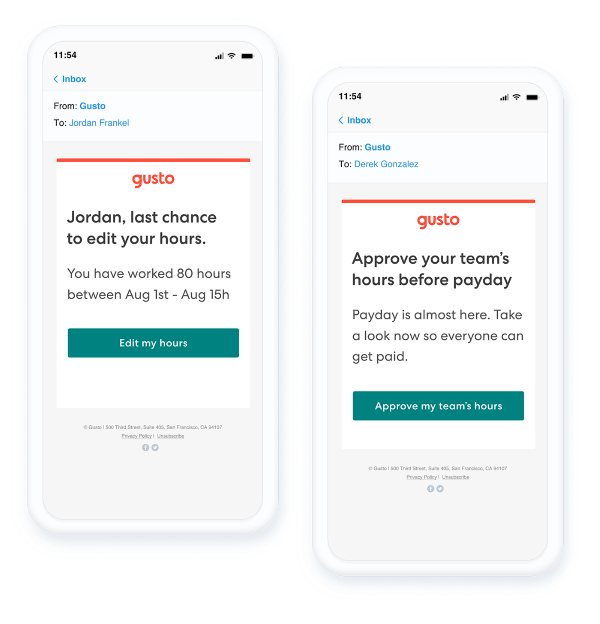
Gusto’s customer support and service are designed to be accessible and easy to use, making it a strong choice for small to medium-sized businesses that need reliable assistance without the complexity of more extensive support systems.
Comparison and Conclusion
When comparing Paycom vs Gusto for customer support and service, the choice depends on the size and complexity of your organization’s needs.
Paycom offers a comprehensive and personalized customer support system, ideal for large organizations that require dedicated specialists and extensive training resources. Its robust support framework ensures that users have access to expert help, making it a powerful tool for managing complex HR needs.
Gusto provides a simpler, more user-friendly support solution that is perfect for small to medium-sized businesses. Its multi-channel support, comprehensive help center, and focus on customer satisfaction make it accessible for businesses with more straightforward support requirements, ensuring that users can resolve issues quickly and efficiently during business hours.
In summary:
- Paycom is ideal for large organizations that need a robust customer support system capable of providing dedicated, expert assistance. Its comprehensive features make it a strong choice for businesses with complex support needs.
- Gusto is better suited for small to medium-sized businesses looking for a user-friendly customer support solution. Its simplicity and focus on ease of use make it an excellent choice for businesses with limited support requirements, ensuring that help is available when needed during regular business hours.
User reviews on platforms like G2 and Capterra generally reflect these characteristics, with Paycom users often praising the expertise of their support team, while Gusto receives high marks for their friendly and responsive customer service.
Ultimately, the decision between Paycom vs Gusto for customer support and service should be based on your organization’s size, the complexity of your support needs, and your preference for personalized service versus simplicity. By carefully evaluating these factors, you can select the platform that will best support your customer service requirements, ensuring that your team has the assistance it needs to use the HCM system effectively.
Pricing and Cost-effectiveness
Pricing and cost-effectiveness are crucial factors when selecting a Human Capital Management (HCM) system, as they directly impact your organization’s budget and return on investment. When comparing Paycom vs Gusto, it’s important to evaluate the pricing structures and overall cost-effectiveness of each platform to determine which solution best aligns with your organization’s financial goals.

Paycom Pricing and Cost-effectiveness
Paycom is positioned as a premium HCM solution, offering a comprehensive set of features designed for larger organizations with complex HR needs. As such, its pricing reflects the depth and breadth of its offerings, typically making it a more significant investment compared to simpler platforms like Gusto.
Key Points on Paycom Pricing and Cost-effectiveness:
- Customized Pricing: Paycom does not publicly disclose its pricing, as it typically provides customized quotes based on the specific needs and size of the organization. However, some sources suggest that pricing may start around $4-$6 per employee per paycheck, with potential setup fees.
- Comprehensive Features: While Paycom’s pricing is on the higher end, the platform offers a wide range of features that are integrated into a single system. This integration can lead to cost savings by reducing the need for multiple standalone tools and minimizing administrative overhead.
- Scalability: Paycom is designed to scale with large enterprises, offering solutions that can adapt as the organization grows. The platform’s ability to handle complex HR processes across multiple departments and locations can justify its higher price point for organizations with expansive needs.
- Cost of Implementation and Training: Paycom’s implementation and training costs can be higher due to the platform’s complexity and the need for thorough onboarding to ensure effective use. However, these upfront costs can potentially be offset by long-term benefits of a fully integrated and automated HR system.
Paycom’s pricing is best suited for large organizations that need a comprehensive, scalable HCM solution. While the initial investment may be higher, the platform’s extensive features make it a potentially cost-effective choice for businesses with complex HR requirements.
For more information about pricing, please visit Paycom’s website.
Gusto Pricing and Cost-effectiveness
Gusto is known for its transparent and straightforward pricing structure, making it an attractive option for small to medium-sized businesses that need a cost-effective HCM solution. Gusto’s pricing is designed to be accessible, offering essential HR features at a lower cost compared to more comprehensive platforms like Paycom.
Key Points on Gusto Pricing and Cost-effectiveness:
- Transparent Pricing: Gusto publicly discloses its pricing on a per-employee, per-month basis, with different tiers available depending on the features required. As of 2024, Gusto offers the following pricing tiers:
- Simple: $40/month base + $6/person/month
- Plus: $80/month base + $12/person/month
- Premium: Custom pricing
- Contractor-only: $6/person/month
- Affordable for Small Businesses: Gusto’s pricing is highly competitive, making it an excellent choice for small to medium-sized businesses that need essential HR, payroll, and benefits management features without the higher costs associated with more complex systems.
- Feature-Based Tiers: Gusto’s tiered approach ensures that organizations only pay for the features they need, enhancing cost-effectiveness.
- Low Implementation Costs: Gusto’s user-friendly design and straightforward setup process mean lower implementation and training costs, making it easy for businesses to get up and running quickly without a significant upfront investment.
Gusto’s pricing is ideal for small to medium-sized businesses looking for a cost-effective, easy-to-use HCM solution. Its transparent pricing structure and affordable tiers make it accessible for businesses with limited budgets, providing essential HR features at a competitive price.
For more information about pricing, please visit Gusto’s website.
Comparison and Conclusion
When comparing Paycom vs Gusto for pricing and cost-effectiveness, the choice depends largely on the size of your organization, the complexity of your HR needs, and your budget.
Paycom offers a premium, customizable pricing model that is best suited for large organizations with complex HR requirements. While the initial cost may be higher, Paycom’s comprehensive features, scalability, and integration capabilities can potentially lead to long-term efficiencies for enterprises that require a robust HCM platform.
Gusto provides a more affordable and transparent pricing structure that is ideal for small to medium-sized businesses. Its tiered pricing model ensures that businesses only pay for the features they need, making it a highly cost-effective option for those looking for essential HR tools without the higher costs associated with more advanced platforms.
In summary:
- Paycom is ideal for large organizations that need a comprehensive, scalable HCM solution and are willing to invest in a premium platform that offers extensive features. The potential for long-term cost savings should be evaluated based on the specific needs of the organization.
- Gusto is better suited for small to medium-sized businesses looking for an affordable, transparent pricing model that provides essential HR features at a competitive price, with clearly defined tiers to choose from.
Ultimately, the decision between Paycom vs Gusto for pricing and cost-effectiveness should be based on your organization’s size, the complexity of your HR needs, and your budget. By carefully evaluating these factors and considering both immediate costs and potential long-term benefits, you can select the platform that will best support your financial goals while providing the HR functionality your organization requires.
User Reviews and Testimonials
User reviews and testimonials provide valuable insights into the real-world performance of Human Capital Management (HCM) systems. They highlight the strengths and weaknesses of each platform from the perspective of those who use them daily. When comparing Paycom vs Gusto, examining user feedback can help determine which platform might be the best fit for your organization.

Paycom User Reviews and Testimonials
Paycom generally receives positive reviews from users, particularly those from large organizations that benefit from its comprehensive feature set and robust capabilities. Based on 903 reviews across multiple software review sites, Paycom has an overall rating of 4.39 out of 5 stars, with a user satisfaction rating of 85%.
Positive Aspects Highlighted in Paycom Reviews:
- Comprehensive Functionality: Users frequently praise Paycom for its wide range of features, which allow organizations to manage everything from payroll and benefits to performance management and compliance within a single platform.
- Integration and Automation: Many users appreciate Paycom’s ability to integrate seamlessly with other systems and automate complex HR processes, saving time and reducing errors.
- Customer Support: Paycom’s dedicated account managers and support team are often mentioned positively in reviews. Users feel supported and appreciate having a consistent point of contact who understands their organization’s specific needs.
Areas for Improvement Noted in Paycom Reviews:
- Steep Learning Curve: Some users report that Paycom’s extensive feature set comes with a steep learning curve, particularly for those who are not as tech-savvy or are new to HCM systems.
- Cost: While many users acknowledge the value Paycom provides, some also note that it can be more expensive compared to other HCM platforms.
Gusto User Reviews and Testimonials
Gusto is highly regarded by small to medium-sized businesses for its user-friendly design and affordability. Based on 3897 reviews across multiple software review sites, Gusto has an impressive overall rating of 4.63 out of 5 stars, with a user satisfaction rating of 93%.
Positive Aspects Highlighted in Gusto Reviews:
- Ease of Use: Gusto is frequently praised for its intuitive interface and user-friendly design. Users appreciate how easy it is to navigate the platform and perform HR tasks without needing extensive training or technical expertise.
- Transparent Pricing: Gusto’s transparent and affordable pricing structure receives positive feedback. Users appreciate knowing exactly what they are paying for and being able to choose a pricing tier that fits their needs without hidden costs.
- Customer Support: Gusto’s customer support is often described as responsive and helpful. Users report positive experiences with the support team, noting that their issues are resolved quickly and with a personal touch.
Areas for Improvement Noted in Gusto Reviews:
- Limited Advanced Features: Some users mention that Gusto’s simplicity, while generally a strength, can be a limitation for businesses that grow beyond a certain size or need more advanced HR features.
- Support Availability: While Gusto’s support is well-regarded, some users note that it is not available 24/7, which can be a drawback for businesses that operate outside of standard business hours or in multiple time zones.
Comparison and Conclusion
When comparing Paycom vs Gusto based on user reviews and testimonials, it’s clear that each platform excels in different areas, catering to different types of organizations.
Paycom (4.39/5 stars, 85% satisfaction) is praised for its comprehensive functionality, robust integration capabilities, and strong customer support, making it ideal for large organizations with complex HR needs. However, the platform’s complexity and cost are noted as potential drawbacks, particularly for smaller businesses.
Gusto (4.63/5 stars, 93% satisfaction) is celebrated for its ease of use, affordability, and responsive customer support. These qualities make it an excellent choice for small to medium-sized businesses that need a user-friendly and cost-effective HR solution. However, its simplicity may be a limitation for organizations that require more advanced features as they grow.
In summary:
- Paycom is ideal for large organizations that need a comprehensive, feature-rich HCM platform and are willing to invest in a more complex system. User reviews suggest that it is well-suited for businesses that can leverage its full capabilities and appreciate dedicated customer support.
- Gusto is better suited for small to medium-sized businesses looking for an easy-to-use, affordable HR solution. User reviews highlight its simplicity, transparent pricing, and strong customer service, making it a popular choice for businesses with straightforward HR needs.
Ultimately, the decision between Paycom vs Gusto for your organization should be based on your specific requirements, the complexity of your HR needs, and the type of user experience you prefer. By considering the feedback from real users and the overall ratings, you can select the platform that will best support your HR goals and enhance your overall operations.
Conclusion
Choosing between Paycom and Gusto for your Human Capital Management (HCM) needs ultimately comes down to the specific requirements of your organization. Both platforms offer strong capabilities, but they cater to different types of businesses and HR complexities.
Paycom Overview
Paycom stands out as a comprehensive, feature-rich solution ideal for large enterprises with complex HR needs. It excels in areas such as payroll management, compliance, integration, and advanced reporting and analytics. Paycom’s robust tools are designed to handle the intricacies of large-scale HR operations, offering deep customization, real-time data integration, and extensive support services. However, this power and flexibility come at a higher cost and with a steeper learning curve, which may require significant investment in time and resources for effective implementation.
Gusto Overview
Gusto, on the other hand, is tailored for small to medium-sized businesses that prioritize ease of use, affordability, and straightforward HR management. Gusto’s user-friendly interface, transparent pricing, and essential HR features make it an excellent choice for businesses that need to manage payroll, benefits, and compliance without the complexities associated with larger platforms. While Gusto may lack some of the advanced features found in Paycom, its simplicity and accessibility make it a highly effective tool for businesses that want to streamline their HR processes without a large financial or time commitment.
Final Recommendations
- Choose Paycom if your organization is large, complex, and in need of a comprehensive HCM solution that can scale with your business. Paycom is particularly well-suited for enterprises that require advanced features, deep integration capabilities, and dedicated customer support.
- Choose Gusto if your organization is small to medium-sized and you value simplicity, affordability, and ease of use. Gusto is ideal for businesses that need a reliable, straightforward HR platform that can be quickly implemented with minimal training.
By carefully evaluating your organization’s needs, budget, and desired level of complexity, you can select the HCM platform that best aligns with your business goals. Whether you opt for the comprehensive capabilities of Paycom or the simplicity and affordability of Gusto, both platforms offer robust solutions that can significantly enhance your HR operations and contribute to your organization’s success.
![]()
![]() Read our full Paycom review
Read our full Paycom review
![]()
![]() Read our full Gusto review
Read our full Gusto review

